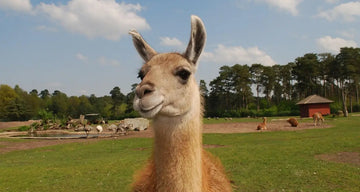Alpaca and llama are sought after by many consumers as high quality natural fibers. This article will delve into the differences and commonalities between llama and alpaca and analyze which material is more suitable for socks.
Difference between a llama and an alpaca
Alpacas and llamas, as natives of the South American Andes, belong to the same family of camelids, but they differ significantly in size, coat, personality and uses.
Size
Llamas are usually larger than alpacas. Adult llamas weigh between 200-400 pounds and are about 42-27 inches tall, while alpacas typically weigh between 110-180 pounds and are around 34-36 inches tall. Their faces and ears are also different; alpacas have flatter faces and shorter ears, while llamas have longer, banana-shaped ears.
Hair
There are significant differences between alpaca wool and llama wool. Alpaca wool is soft and delicate, and has been described as a “luxurious natural fiber” that is often used to make socks. Llama wool, on the other hand, has a rougher feel and is often used for blankets. In addition, alpaca has more than 20 natural hair colors, including white, black, gray and red.
Personalities
Llamas have an independent and assertive personality, which stems from their historical reasons for being the guardians of their herds. Llamas are solitary animals with a strong sense of territoriality and are quick to spit when threatened. Alpacas, on the other hand, are gentle and shy, preferring to live in herds, are curious, and generally try to avoid conflict.
Uses
Llamas are valued for their versatility as working animals, with their strong bodies and stamina enabling them to travel over rough and rugged terrain, and are often used as guard animals to protect livestock from predators.
Alpacas are loved for their soft, warm fur. Soft, fine and lightweight, alpaca wool has excellent warmth, breathability and natural antibacterial properties, and is often used to make socks and other apparel that emphasizes comfort and functionality.

What alpacas and llamas have in common
While llamas and alpacas are quite different in appearance and use, their coats both offer some unique natural advantages.
Both alpaca and llama wool have excellent warmth and breathability, which stems from the fact that they both survive the harsh weather of high altitude, where the wool is needed to help regulate body temperature for the ever-changing outdoor environment.
In addition, they both have some natural antimicrobial properties that inhibit bacterial growth and reduce odor.
Alpaca vs llama, which material is better for socks?
When it comes to choosing the best material for socks, alpaca wool has more advantages. Alpaca fibers are finer and have a more delicate feel, resulting in socks with a better fit and less friction and blisters. Secondly, alpaca wool is lighter in weight, making alpaca socks lighter and better performing for the same sock thickness. Finally, both have a certain degree of moisture absorption, but alpaca wool is more suitable for outdoor sports such as hiking and mountaineering due to its natural hollow fibers that can absorb and discharge sweat faster and keep feet continuously dry.
In summary, alpaca socks win in terms of fineness, weight, and moisture wicking properties, making them the ideal material for high-end socks. At Clohill, we value quality and functionality in our socks, and we use only the finest alpaca wool to create socks that combine comfort and performance.
How do I care for my alpaca and llama products?
High-quality natural fibers need to be cared for in the right way to prolong their life. Here are a few practical suggestions we have summarized:
Alpaca socks washing: We recommend hand washing in cold or lukewarm water, adding the right amount of mild detergent, rubbing gently to dry and pressing to squeeze out excess water, lay flat to dry. Avoid machine washing and drying.
Llama wool product care: Llama wool is more durable and can withstand rougher washing. However, do not use the dryer during the washing process. You can use a moderate amount of softener to help maintain the feel and luster of the product.
How to store: Once cleaned, the product can be stored in a cool and dry place to avoid fiber damage caused by friction with sharp objects.
Final Thoughts
In the comparison between llama wool and alpaca wool, it is found that both possess different advantages and we need to choose the right product according to our needs. If you are looking for comfort, extreme warmth and breathability, choosing alpaca socks is crucial. On the other hand, llama products have become the first choice for outdoor clothing due to their outstanding durability.
Frequently asked questions about alpaca and llama
1.Can I make socks from llama wool?
Llama wool has coarse fibers and is suitable for coats, blankets, etc. It is not recommended for socks.
2. Which is more expensive, alpaca or llama wool?
Alpaca wool is of higher quality, softer, and produced in smaller quantities, making it more expensive.
3. Can alpaca wool socks cause allergies?
No. Alpaca wool socks are soft and fine to the touch. Alpaca socks have a soft, delicate feel and are allergen-free, so they are not usually associated with skin allergies.
4. Which is better for outdoor clothing, alpaca or llama?
Alpaca wool is more suitable for outdoor hiking socks, while llama wool is often used for outdoor clothing due to its excellent abrasion resistance.








